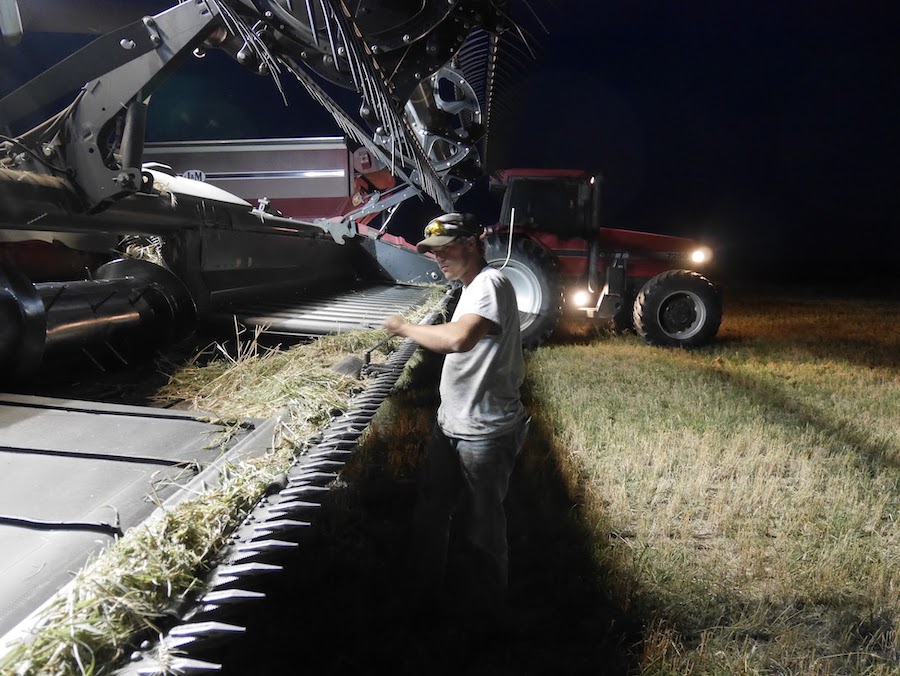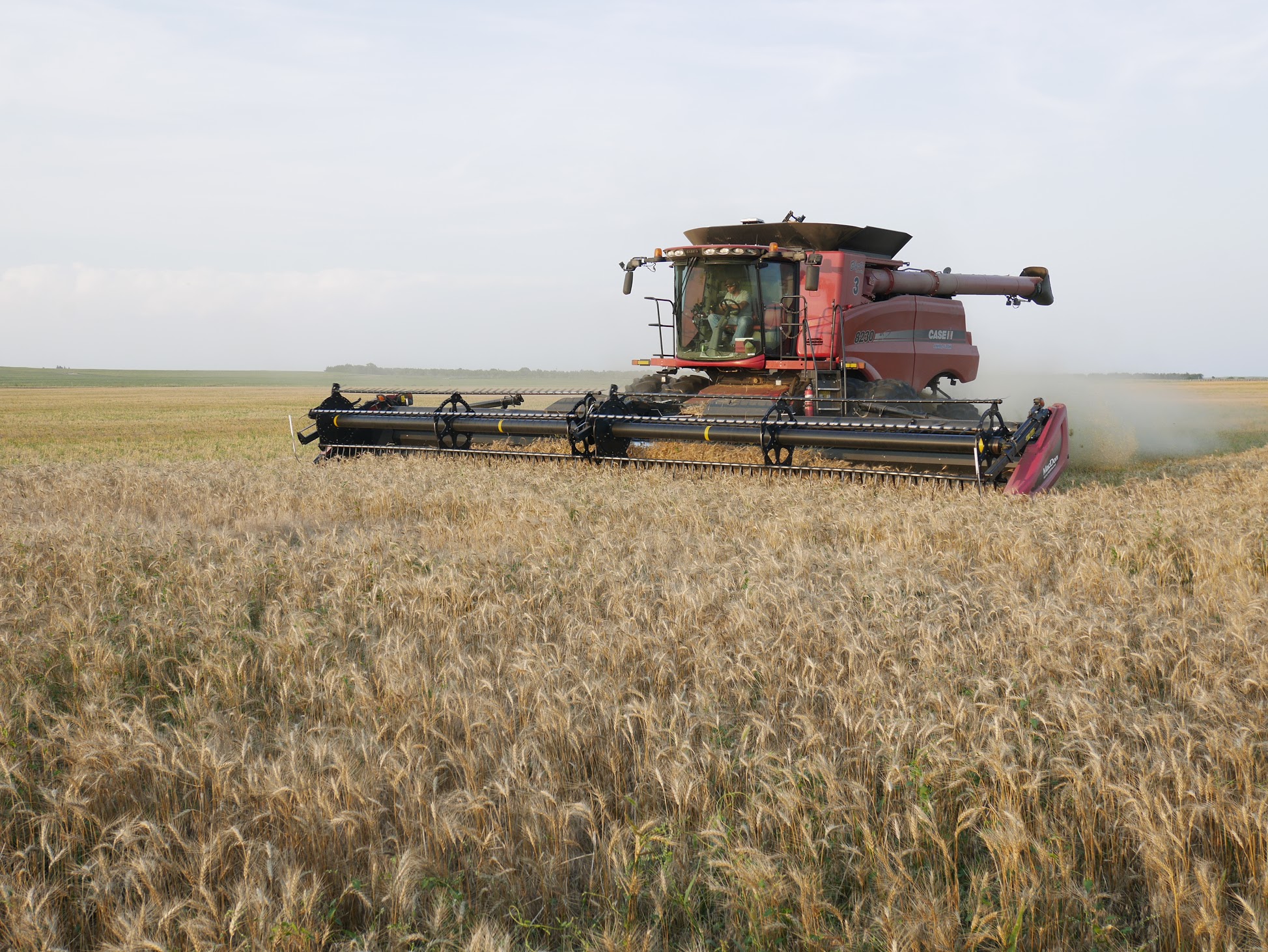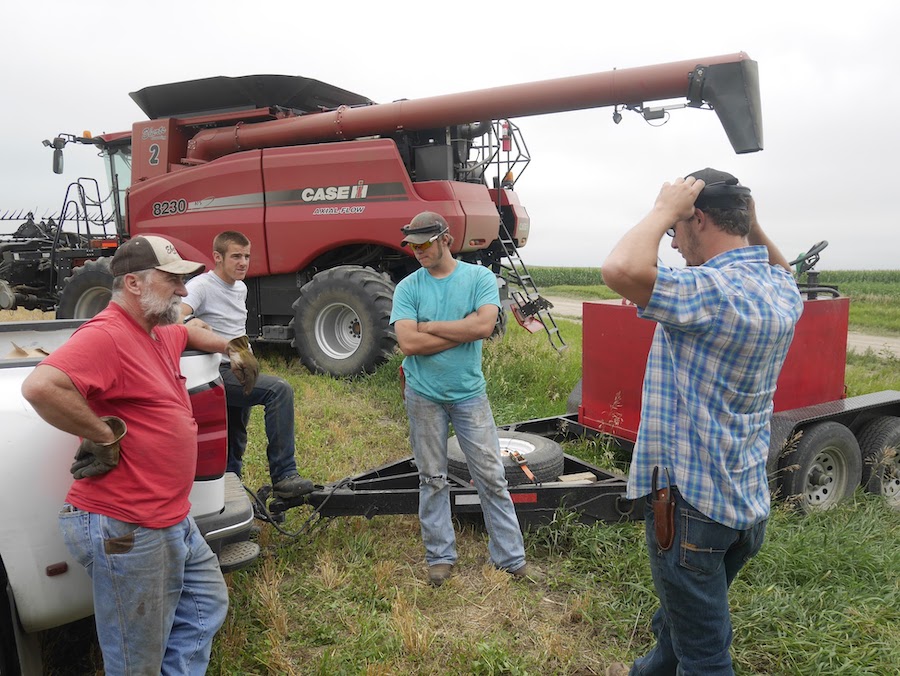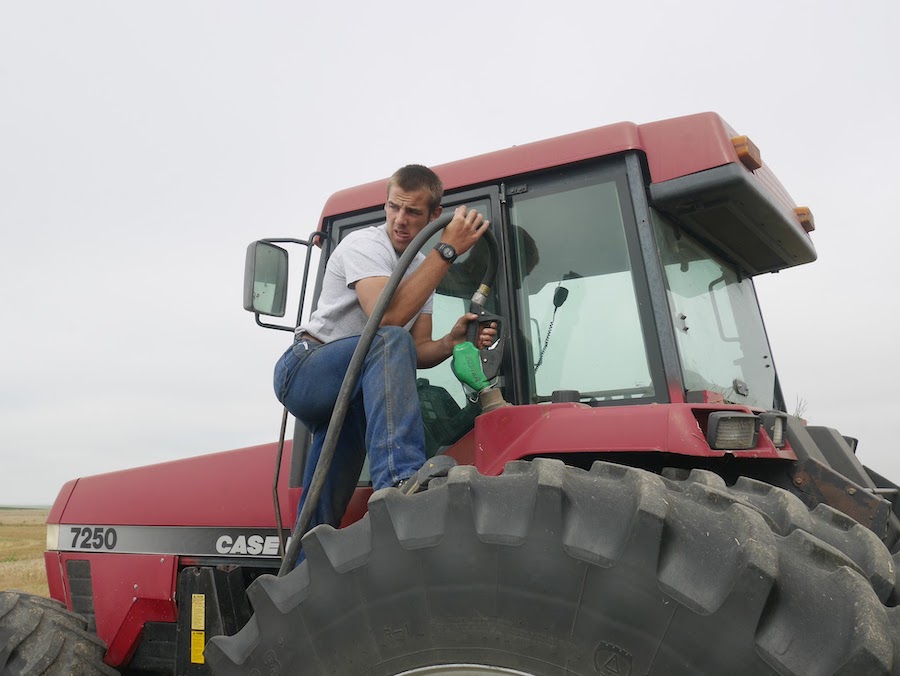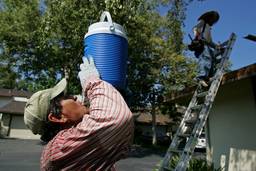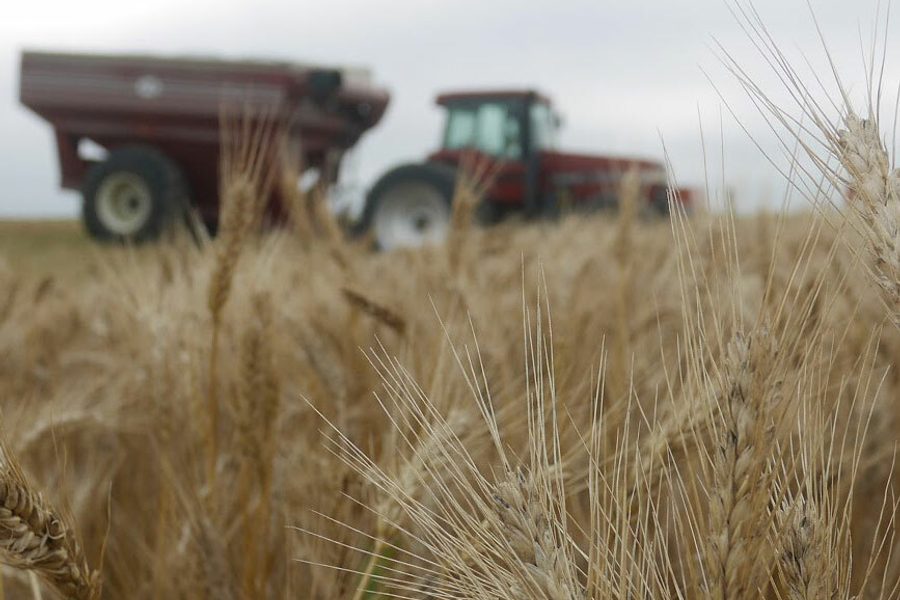
After cutting their final acres of wheat in eastern Colorado, Jim and Tracy Zeorian, the husband and wife team that make-up Zeorian Harvesting and Trucking, started the process of loading their combine, header truck, and trailer to make the journey to their next job in Jordan, Mont. Even after the two trips needed to move their equipment, they were still early. The spring wheat they planned to cut wouldn’t be ready for a few weeks, but that didn’t mean it was time to rest.
After setting up camp in the small RV park tucked away on the edge of town, Jim parked their bright yellow, New Holland combine with contact information in the windshield next to the café that marks the town’s western entrance.
Tracy, a third-generation harvester, has been coming to Jordan since 1981. In those days, there were enough custom harvesters — also known as custom cutters or “Wheaties” — that they would all set-up together on the outskirts of town in makeshift camps that would disband as soon as they moved onto the next town. Many harvesters already had work lined-up, but others arrived in hopes of finding jobs, and it was common for harvesters to park their equipment in a public place so that farmers with acres to cut could easily find and hire them.
Those days are mostly over. The large, raucous harvest camps of the past are a stark contrast to the Zeorian’s inconspicuous campsite adorned with picnic table, grill and potted flowers. Back then, Jordan might have had as many as 20 crews looking for work, but in 2018, Zeorian’s was the lone combine sitting outside town.
Since World War II, custom harvesting has been integral to the social and economic fabric of wheat belt states like Oklahoma, Kansas, Montana and the Dakotas. Starting in the southern plains in the spring, harvest crews would move from town to town, following the ripening wheat north throughout the season.
Harvest season would bring much hope and anticipation, and although Tracy feels that eagerness as keenly as ever, today, harvesters can enter and leave a town with hardly any notice. There are fewer acres of wheat and fewer harvesters needed to cut them, but as much as anything, custom harvesting’s shrinking cultural imprint is intertwined with the decline of rural America.
One of the Eberts’ field hands cleans a combine header in order to fix a broken blade. (Michael J. Dax)
Over the course of the 20th century, many rural farming communities came to depend on the economic activity generated by harvest crews. In addition to the farmer, whose yearly income relied on a good harvest, restaurants, bars, hardware and grocery stores and gas stations all received a dependable boost for the couple weeks each year when harvest crews came through town. Other businesses directly tied to agriculture like equipment dealerships and grain elevators existed solely because of the harvest.
As a result, the harvest became essential to creating and maintaining the cultural and social networks that have unified the Great Plains as a region. Historically, it served as a rite of passage for farm kids who made-up the majority of harvest crews. The height of harvest could bring more than 100 wheaties to some of the larger towns like Frederick, Okla. and Colby, Kan. Not only would these large gatherings allow for people across the region to get to know one another, form friendships and comradery between crews, but inevitably the harvest also led to romances that further solidified a shared sense of regional identity.
“This was a spectacular and rewarding way of life,” says Tom Isern, a history professor at North Dakota State University in Fargo whose 1981 book, Custom Combining on the Great Plains, details the industry’s early years. “If it came up in conservation, they [former harvesters] wanted to talk about it.” But gradually, both as a cause and effect of rural America’s struggles, the harvest’s significance— culturally and economically — has waned.
As much as anything, these economic and social lifeways and traditions are a product of the unpredictable nature of harvesting. Throughout the season, harvesters often find themselves at the mercy of the weather. A long stretch of rain can put a crew at a standstill for as much as a week, so that when they get back in the field, they need to work as quickly as possible in order to reach the next job. This unpredictably and lack of control over their schedule often means that when they do get in the field, they are working early mornings and late nights, doing whatever it takes to get the crop off.
Nancy and Myron Eberts, based in South Heart, N.D., have been making the harvest for 40 years. They recall their early days when everyone would pull together to help with the harvest. Grain elevators would stay open late, café owners would keep the kitchen open and allow harvest crews to call in their orders, and grocery stores would let crews run a tab while they were in town. Harvesters developed close relationships with local dealerships who made sure to have certain parts in stock so that a broken-down combine could be fixed as soon as possible. Even local post offices were willing to work with harvesters who never knew for sure where they were going to be and when.
Nancy Eberts taking a break in her trailer after breakfast. (Michael J. Dax)
But slowly, cafes and grocery stores have closed or been replaced by national chains unwilling or able to tailor their business to accommodate the harvest. Grain elevators have also been bought by larger corporate entities and are more likely to keep predetermined hours. Equipment dealerships have consolidated as well, sacrificing the personal relationships that harvesters developed. “We’re losing that hometown feel,” says Myron.
When he first started harvesting, Goodland, Kan., had two grocery stores, both of which closed when Wal-Mart moved in. Massey-Ferguson, International Harvester, and John Deere all had dealers in Kiowa, Kan., but none of them exist today. In his hometown of South Heart, N.D., all that remains of the two bars, grocery store and agriculture co-op that once existed is a single bar and some gas pumps.
“For the most part, small towns in the wheat belt – nothing’s growing,” says Jim Zeorian. “They’re all losing. Only a few towns still recruit enough harvesters to feel like the old days.”
Although harvesters were generally derided as rowdy, nomadic gypsies — a label worn as a badge of honor by many — towns depended on the harvest as much as harvesters depended on the towns, and without that infrastructure, their job has become considerably tougher.
Cutting wheat in the late afternoon of a South Dakota summer day. (Michael J. Dax)
Hiring crew members has also become more challenging as outmigration from the region has grown. In 1970, roughly 26 percent of Americans lived in rural areas and about 4.6 percent of the labor force was famers. Today, rural residents make up only 14 percent of the population and less than 2 percent are farmers. This has made it harder for harvesters to find farm kids who are familiar with the equipment and lifestyle that the harvest trail demands.
With just one combine, the Zeorians no longer need an extra crew member, but when they did, they always hired someone from their home in eastern Nebraska. Fittingly, the first person they ever hired now works for a New Holland dealer and is their local sales representative. He was 16 years old when he did his first of three seasons with the Zeorians. “He just became part of the family,” recalls Tracy. “When you have a good crew, they just do.”
The Eberts run two or three combines with at least three trucks and a grain cart, necessitating a crew of at least five, which is considered a small or midsize crew. They, too, view their hired hands as an extension of their family and appreciate the opportunity to impart their knowledge and skills. “We used to say that people would bring us their boys and at the end of the summer we’d give them back their men,” says Nancy.
For 30 years, they never had any problem finding good help, but more and more it has been tough. In addition to a smaller pool of potential workers, parents are less likely to let their teenagers leave for the summer, and fewer young Americans are attracted to the work, which is unpredictable and requires long hours. Accordingly, crew members are far more likely to leave mid-season than they ever were in the past. “Times have changed. People have changed,” says Nancy. “If someone doesn’t like it, they’re gone. There’s not that stick-to-it-ness.”
The Eberts’ crew takes a break while waiting for the morning dew to burn off. (Michael J. Dax)
This has compelled harvesters to rely on foreign workers with temporary H-2A visas, which are designed specifically for agricultural work. Most of these workers originate from other wheat producing countries like Ireland, South Africa and Australia. For them, it’s an opportunity to gain experience they can then apply at home. By the nature of their visas, these workers tend to be more reliable because they must stay for the entire season if they want to remain in the country. Especially for larger harvesting outfits, H-2A workers have become the norm as the prospect of having to rehire throughout the season is impractical and inefficient.
Long-term, this shift has started to have an impact. The fact that foreign workers eventually return home has undermined the unity that once bonded] the Great Plains. “There’s a social impact,” says North Dakota State’s Isern. “Its decline is part of the erosion of social networks that used to tie together town and country, and even Texas to Montana. It’s a piece of the loss of rural culture.”
Relationships between harvesters and their crew members aren’t the only ones that have suffered in recent years. Overall, agriculture has become far less profitable. Crop prices have stagnated, corporations have more control over the industry, and to survive farmers have had to be savvier businessmen. Harvesters still rely on handshake agreements with the farmers they work for, but the loyalty that used to tie them is not as strong as it once was. “Our customers are still pretty loyal to us because we’ve done business for so many years,” says Myron. “But I know other guys that don’t have that.”
According to Isern, especially in situations where the son of a farmer had worked for the harvester, interlocking family relationships created a “moral economy” that tied them to one another. Now, with fewer younger Americans working the harvest, these kinds of relationships that foster loyalty are far less common.
One of the Eberts field hands fueling up the tractor, which pulls the grain cart. (Michael J. Dax)
The Zeorians have been at the mercy of this shifting dynamic. “It used to be more of a loyalty thing,” says Jim. “Now it’s more based on ‘can you cut it cheaper than he can.’”
This has left many harvesters scrambling to find work, and with 2017 and 2018 seeing the fewest acres of wheat planted since 1920, it’s not easy to do. Due to GMOs and hybridization, farmers are able to plant corn and soybeans in arid regions that once could only support wheat. This has further hurt harvesters because across the Midwest, these crops ripen in the fall and don’t create the seasonal migration that wheat does. “Everyone has to look out for themselves,” concedes Jim. “But in todays’ climate it would be safe to say, it’s a little easier for them to say, ‘We just can’t use ya.’ ”
As a result, the industry has progressively faded into anonymity. “Even in our small little rural community, people don’t understand what we do,” says Tracy. “Unless you live within the wheat belt where combiners come through, most people don’t know anything about it.”
The changes that have come to custom harvest industry are a microcosm of the transformation altering life in rural American and the Great Plains as a whole. These places thrived because of the personal relationships and sense of community that rural living necessitates, but with every local restaurant or equipment dealership that closes, with every teenager who won’t have the memory of the summer harvest, and with every harvester no longer able to make a living, the loss of community accelerates, taking with it the hopes for the future.
